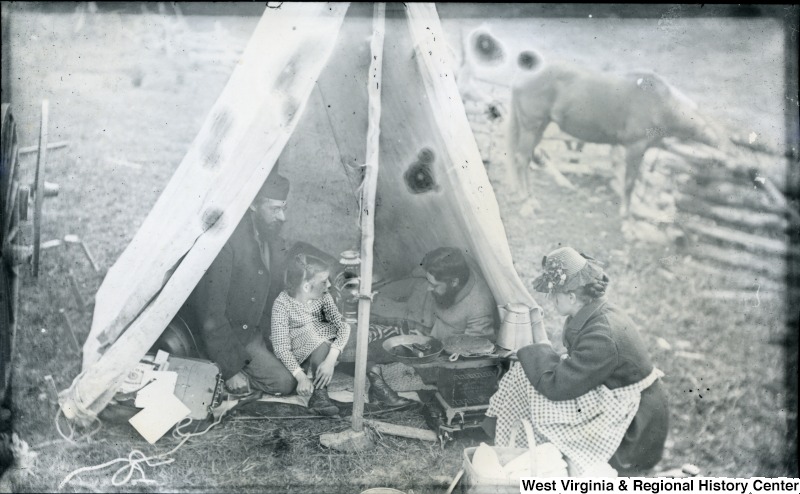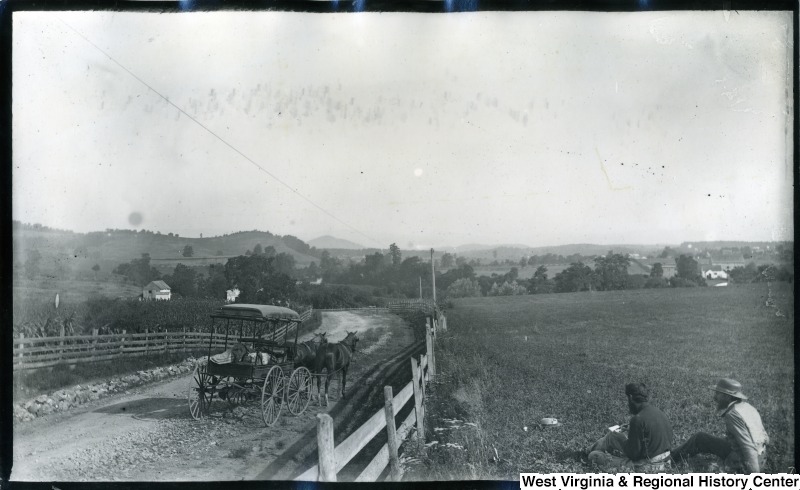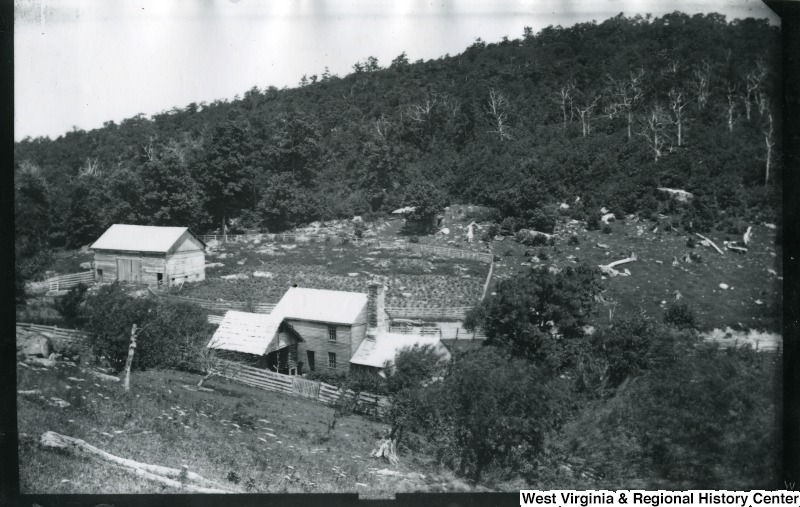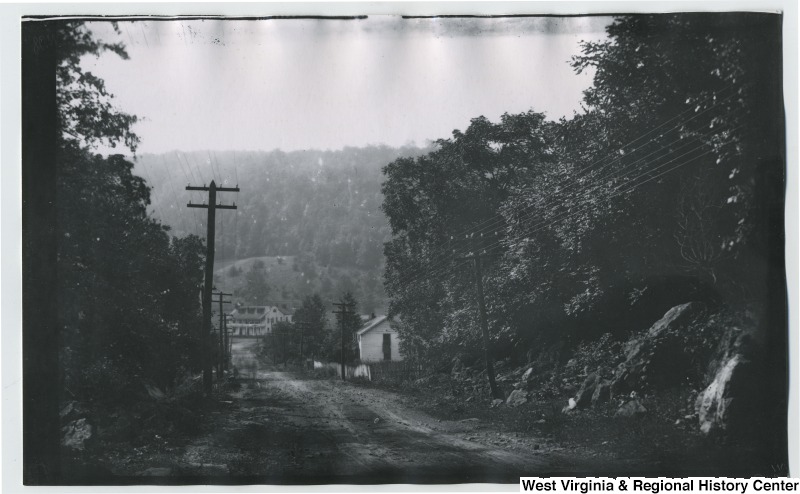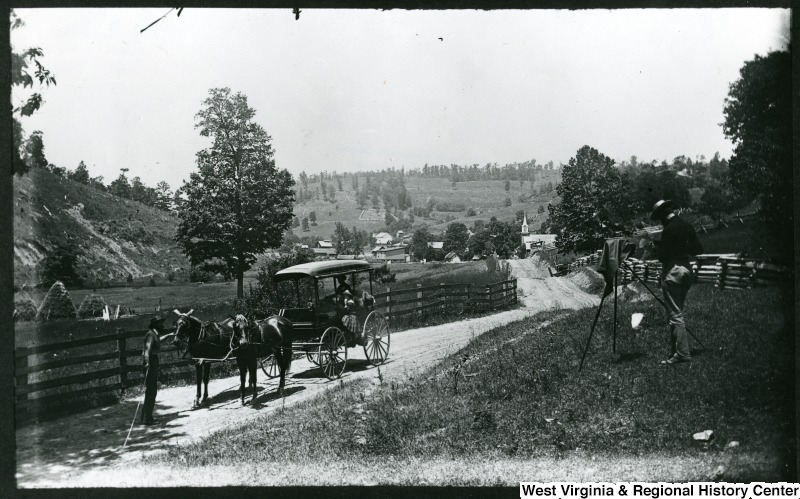Thomas and Walter Biscoe and their 1884 Allegheny Valley Tour
Posted by Jane Metters LaBarbara.July 6th, 2016
Blog post by Lori Hostuttler, Assistant Director & Digital Projects and Outreach Archivist, WVRHC.
In 1884, Thomas Dwight Biscoe and his brother Walter Stanley Biscoe headed out on a trip across West Virginia, Virginia, Maryland and Pennsylvania, traveling by horse and buggy and camping out as needed. With Thomas’ wife and daughter in tow, they captured the sights and scenery of the trip by taking over 200 photographs along the way. The unique images document the region and battlefield sites just a little less than twenty years after the end of the Civil War. Marietta College in Ohio owns the original glass plate negatives. Copies from the plates can be viewed in in West Virginia History OnView, the West Virginia & Regional History Center’s online photographs database.
Thomas Biscoe (left) and Walter Biscoe (right) having breakfast in their tent on July 11, 1884. Thomas notes that the image was taken at 6:30 in the morning and that the day was clear. The young girl and woman are very likely Thomas Biscoe’s daughter, Alice, and his second wife, Mary Ellen.
The Biscoe brothers were both successful scholars. They hailed from Grafton, Massachusetts, sons of Reverend Thomas C. and Ellen E. Lord Biscoe. Thomas was the third born of nine siblings, while Walter was the eighth. Their father was a minister in the Congregational Church.
Thomas Dwight Biscoe with his camera. Image from the Ohio Memory Collection.
Thomas Biscoe (1840 – 1930) attended Amherst College and the East Windsor Theological Institute. He served as a tutor and a professor of Mathematics at Amherst for several years before studying in Germany and then teaching in Cincinnati, Ohio. In 1874, he joined the faculty of Marietta College where he was a professor of sciences. Thomas taught geology, mineralogy, chemistry, and physics. In addition, he faithfully recorded Marietta’s weather for the United States Weather Bureau for forty years. Throughout his life, Thomas had a passion for photography. He kept painstakingly detailed notes about the images as he took them and developed them in a photography studio in his home.
Portrait of Walter Stanley Biscoe. Image from Library History Buff.
Walter Stanley Biscoe (1853 – 1933) was thirteen years younger than Thomas. He was also educated at Amherst College, graduating in 1874. Like his brother, Walter first taught Mathematics at Amherst, but soon he became Assistant Librarian. He succeeded his former Amherst classmate, the noted librarian Melvil Dewey, creator the Dewey Decimal Classification System for library books. Walter Biscoe followed Dewey to Columbia University and later to the New York State Library in Albany. He was instrumental in developing the second and third editions of Dewey’s Classification System, carefully working out the specific details. He served as Senior Librarian at the New York State Library from 1896 until his retirement in 1931. The book collection at the West Virginia & Regional History Center still uses the Dewey Classification system to this day.
The Biscoes sit in the grass at right. Their buggy is on the road near Mount Crawford, Virginia on July 23, 1884. The brothers and fellow travelers, their buggy, and camp sites appear in images throughout the collection.
Walter clearly had the same gift for detailed work as his brother Thomas. Their thorough documentation of this trip left an extraordinary record of the late 19th century landscapes in the central Appalachian region. The images show a number of Civil War battlefields including Rich Mountain, Fisher’s Hill, Cedar Creek and Antietam among others. For many of the battlefield images, the photographers’ notes describe the fighting in those areas.
Battleground at the Top of Rich Mountain from Union Side Looking North, July 15, 1884.
Cedar Creek Battlefield View West from General Crook’s Camp, Wednesday, July, 30, 1884, 11:00 a.m. The caption goes on to say, “This view looks up the rather open valley of Cedar Creek, whose left on NE bank was occupied by the Union army. The fighting was mainly at the extreme right of this view and along down the pike for several miles. The mts. in the distance mark the western part of the Shenandoah Valley.”
A view of Bloody Lane on the Antietam battlefield in Maryland taken August 6, 1884.
Old Tavern about nine miles West of Cumberland, August 13, 1884. The tavern in the distance in the center of the photo is the Clarysville Inn which served as a hospital during the Civil War. Take a look at the WVRHC’s online collection of bed cards from the hospital.
In addition to battlefields, the Biscoes also photographed many communities across the region. Some of these towns are small and few images of them from the nineteenth century exist.
Auburn from Mr. Cookman’s Yard, July 8, 1884, Tuesday at 12 noon. Very Clear. Auburn is located in Ritchie County.
Threshing wheat near Troy, Gilmer County. July 9, 1884. Wednesday, 11:05 a.m.
Charles Town, Old Virginia, From Pike 3/4 of a Mile South of Town, August 1, 1884, Friday 5:20 pm. clear sun; Bonfire burning on right. Court house with clock tower in center.
The Biscoe photographs reveal the Allegheny Valley region nearly two decades after the Civil War. Thomas Biscoe’s detailed annotations provide specifics about the images that we normally don’t have for photos from this era. While biographical sources on Walter Biscoe do not mention photography, he certainly contributed to this collection of photographs. His impact on the library profession is impressive (and a surprise to this librarian/researcher!) Take time to check out this great resource from the WVRHC. All 205 Biscoe images sorted by date order are available here.
Note:
Southern Methodist University also has an online collection of Biscoe prints, containing about half the number in the WVRHC’s database. These prints show the detailed notes written on the card mounts.
Sources:
Information on the Biscoe Collection at Marietta College
Biographical Record of the Alumni of Amherst College During Its First Half Century, 1821-1871






